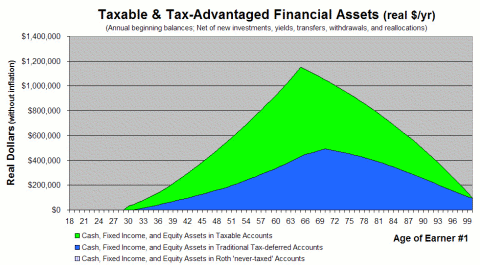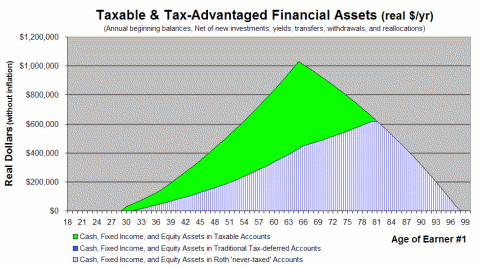In a series of articles, The Skilled Investor compares different lifetime financial planning projections for Fran and Fred Frugal to illustrate the relative value of adopting different financial planning strategies. Fran and Fred, both ages 30, are a married working couple with $100,000 in combined annual earned income. (See the "Fran and Fred's Baseline Lifetime Planning Assumptions" section at the bottom of this article for more information about Fran and Fred's current personal finances and their other lifetime financial planning assumptions.)
Fran and Fred's baseline lifetime financial plan is described in an article entitled: "Retirement Savings Needs of Renters -- prior to any financial planning improvements." Obviously, in this baseline scenario Fran and Fran have NOT adopted many of the lifetime financial planning practices that would make it easier to achieve financial success in life.
Fran and Fred's lifetime financial plan, when they use traditional IRA contributions
In their non-optimized baseline lifetime projection scenario, Fran and Fred did not utilize any tax-advantaged retirement investment accounts, such as IRA or 401k accounts. The following graphic shows Fran and Fred's lifetime baseline projection, when they DO NOT MAKE any contributions into IRA accounts or into any other tax-advantaged retirement plan. Their financial assets are projected to be exhausted when they are age 95.
In another scenario, Fran and Fred tested whether making traditional IRA contributions over their working years would have a substantial effect on their baseline projection. The results of Fran and Fred's "traditional IRA contributions only" scenario can be found in the graph below.
This graphic projects what would happen if Fran and Fred were to utilize 100% of their maximum traditional IRA contributions, during their working years. The solid blue wedge represents the build-up and draw-down of their traditional tax-advantaged IRA assets. The green wedge projects their taxable assets.
Instead of their assets running out at age 95 in their baseline "no IRA" scenario, their assets are projected to last until they are both at least age 100. Furthermore, at age 100 they are projected still to have about $98,000 in remaining assets -- mostly in tax-advantaged accounts, which would cover their living expenses for almost another two years, until age 102 for both.

See this article for a discussion of Fran and Fred's "traditional IRA contributions only" scenario: "Benefits of Traditional IRA Contributions for Renters." Note that in this traditional IRA projection scenario, Fran and Fred DID NOT also evaluate whether to make any additional contributions into 401k, 403b, Keogh, or other retirement investment accounts. Given that Fran and Fred also build up substantial taxable assets, additional contributions into other tax-deferred accounts would tend to increase the lifetime benefits that they are projected to achieve through traditional IRA contributions only.
What if Fran and Fred instead make 100% of their annual IRA contributions into Roth IRA accounts rather than into traditional IRA accounts?To find out the answer to this question, Fran and Fred modeled their lifetime cash, bond, and stock fund assets in both taxable and tax-deferred IRA accounts. In this scenario, Fran and Fred are only evaluating the possible lifetime value of using "Roth IRA" accounts which are currently limited to annual contributions of $4,000 per year, plus an additional $1,000 for over age 50 contributions. Because the tax rules related to IRAs are almost bizarrely complex, we will not go into further detail. The lifetime financial planning tool that Fran and Fred use fully automates these complex rules, so that they can focus on personal financial decision-making.
Contributions to traditional style accounts allow for a reduction in current income to the extent permitted by the tax laws. Assets grow tax free until they are taxed in retirement either: due to withdrawals to cover necessary living or tax expenses or due to mandatory withdrawals that would force income tax recognition in retirement. In contrast, Roth IRA contributions DO NOT reduce current taxable income, but the appreciation on Roth IRA assets are not taxed when withdrawn in retirement.
In effect, Fran and Fred are testing whether paying taxes now or later would have a higher or lower lifetime value in "real dollar" or constant purchasing power dollar terms after expected inflation has been removed from the analysis. It turns out that these tradeoffs are rather involved, and it is necessary to do full lifecycle financial modeling using your particular current and future financial circumstances. For the majority of people, making traditional IRA contributions tends to be more advantageous than making Roth IRA contributions. (See the section below for a better understanding of the personal finance factors that could make Roth IRA contributions more advantageous.)
Fran and Fred are typical of the majority of people. For them, making Roth IRA contributions are LESS advantageous than making traditional IRA contributions across their working years. In comparison to the two graphics above, making Roth IRA contributions increases the age when their financial assets are projected to be exhausted from age 95 until about half-way through age 97. The wedge with vertical blue and white stripes below represents their projected Roth IRA assets over their lives.

Roth IRA contributions are not as beneficial to Fran and Fred, as traditional contributions would be. With traditional IRA contributions, their financial assets are projected to last beyond age 100 (see the second graphic above.)
Which personal finance factors tend to favor Roth IRA contributions over traditional IRA contributions?Many people struggle with the "traditional versus Roth" contribution decision for their personal financial and investment planning. The tradeoffs over a lifetime are very complex. Rules-of-thumb, back-of-the-envelope calculations, and simple spreadsheets cannot model all the important personal financial factors. The decision is not simply about present versus future tax rates. Instead, the decision requires a personalized and comprehensive projection and valuation of your lifetime income, expenses, debts, net assets, and taxes.
Because The Skilled Investor has developed a comprehensive and automated financial lifecycle planner, we are in a relative unique position to comment on this complex topic using the results of our model. We can rapidly model and project personal financial tradeoffs across anyone's lifecycle, while taking into account personal taxes across one's lifetime in eight federal, state, and local tax categories.
Whether or not a person or family will save enough and invest efficiently across their lifetime dominates the "Roth versus traditional" contribution decision. If you do not save aggressively and you do not grow a very substantial investment asset portfolio for your retirement and estate, then you will not have to worry about being in high tax brackets in retirement. If you will not have substantial assets and income in retirement, then the current tax savings you can get from contributing to a traditional tax-advantaged plan will tend to be much more economically advantageous to you over your lifetime.
If you are to justify making current Roth contributions, here are eight personal circumstances or personal financial variables that, taken together, might reverse the average person's preference for traditional tax-advantaged retirement plan contributions:
1) You are a younger investor now, and you have a long time for your assets to appreciate before and during retirement.
2) You are likely to make high enough taxable earned income over your working lifetime to have a realistic chance of amassing enough assets to cover your retirement expenses easily and to have excess estate assets.
3) Your earned income will continue to rise in real dollar terms across your working lifecycle enhancing your future ability to feed your investment program through savings.
4) You will save at significant percentage rates across your working lifetime. This means consistently saving at rates that are well in excess of 10% of your gross earned income.
5) You will fully fund either traditional and/or Roth IRA and other tax-advantaged accounts up to annual contribution limits.
6) In the early years, you may have proportionately higher front-loaded itemized deductions (e.g. mortgage interest and real estate taxes) and lower earned income that effectively lowers your federal, state, and local marginal ordinary income tax rates compared to your income tax rates during more distant retirement years.
7) You will adopt a very low-cost investment strategy to improve your chances of capturing higher asset appreciation rates. Therefore, you will not transfer a significant percentage of your asset returns annually to financial intermediaries who will promise to deliver more, but who are more likely to deliver less.
8) You will maintain an investment asset allocation that is skewed heavily toward equities, and your assets will continue to grow at rates that are similar to long-term historical rates of return.
To learn more about the tradeoffs between traditional and Roth tax-advantaged accounts, see this article on The Skilled Investor website: "Factors that tend to favor Roth tax-advantaged plan contributions."
VeriPlan lets you focus on your own particular financial needs, circumstances, and goals. VeriPlan is the most powerful and sophisticated do-it-yourself financial planning software available to you.
As a fully integrated lifetime personal financial planner, VeriPlan automatically and instantly projects annual values over your lifetime for your family's income, living expenses, debts, taxes, taxable and tax-deferred assets, and property. Every VeriPlan lifetime projection presents your personalized financial information net of your federal, state, and local taxes and your investment costs.
Fran and Fred's Baseline Lifetime Planning Assumptions
Both ages 30, Fran and Fred Frugal are a married working couple with $100,000 in total annual earned income. Their major lifetime financial planning goals are to have enough financial assets until at least age 95, in case both live that long. These are Fran and Fred's major baseline projection assumptions.
NOTE: Of course, some of Fran and Fred's assumptions are not optimal. In various scenarios, we will change these assumptions to illustrate the relative value of different financial planning improvements. (IN THIS SCENARIO, FRAN AND FRED WILL MAKE MAXIMUM CONTRIBUTIONS TO EITHER ROTH IRA OR TRADITIONAL IRA TAX-ADVANTAGED RETIREMENT ACCOUNTS TO SEE WHICH IS BETTER FOR THEM.)
Fran and Fred expect the following:
WORKING INCOME: Both intend to work full-time, until retirement at age 65. They expect their earned income to grow with the rate of inflation.
RETIREMENT INCOME: They expect to collect 60% of currently quoted Social Security retirement benefits. They do not expect to have any pensions.
LIVING EXPENSES: They expect that their living expenses, before and after retirement, will grow with the rate of inflation. They plan always to rent and never to buy their residence. They do not plan to have any children. They expect that their retirement living expenses with be the same as their living expenses, when they were working.
DEBTS: They plan to pay off their current $20,000 in educational debts and $15,000 in credit card debt, as required by these debt contracts. Then, they plan to remain debt free throughout their lives.
TAXES: They plan to file income taxes using standard tax deductions. They expect always to live in Massachusetts, a state with a 5.3% flat income tax rate.
INVESTMENT STRATEGY: They now have $10,000 in money market funds, $10,000 in bond funds, and $10,000 in stock funds. They expect to use an average investment strategy with an average asset allocation throughout their lives. They intend to hold only money market fund, bond fund, and stock fund investments. They hope to earn very long-term historical asset class investment rates of return. They plan to pay average investment costs. They intend to buy-and-hold very broad market index funds, to withdraw assets only to meet expenses, and to pay long-term capital gains tax rates, as much as possible.
TAXABLE versus TAX-DEFERRED ACCOUNTS: They expect to use only taxable investment vehicles and do not plan to use any tax-advantaged retirement accounts.
